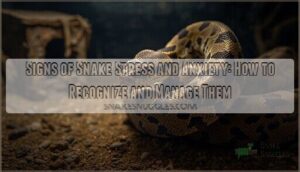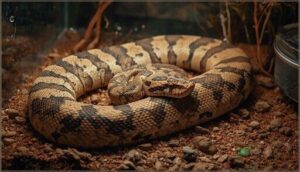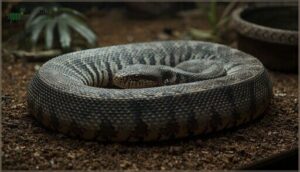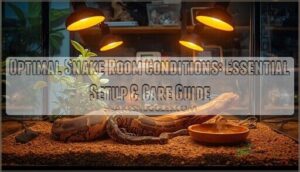This site is supported by our readers. We may earn a commission, at no cost to you, if you purchase through links.

These aren’t quirks or mood swings; they’re warning lights flashing on your reptile dashboard. Recognizing the early signs of snake stress or anxiety isn’t just about preventing a bite—it’s about protecting the fragile balance that keeps your companion healthy. Once you know what to watch for, you’ll see the story their behavior tells.
Table Of Contents
- Key Takeaways
- Common Signs of Snake Stress
- Behavioral Indicators of Snake Anxiety
- Physical Symptoms of Stress in Snakes
- Environmental Factors Contributing to Stress
- Managing and Reducing Snake Stress
- Frequently Asked Questions (FAQs)
- How do I tell if my snake is stressed?
- What can stress do to a snake?
- How to destress a snake?
- What are signs of discomfort in snakes?
- How can stress affect snake reproduction?
- What role does diet play in stress management?
- Do snakes react to loud noises differently?
- How does seasonal change influence snake stress?
- Can snakes experience stress from other animals nearby?
- Do snakes exhibit stress differently by species or age?
- Conclusion
Key Takeaways
- Snake stress manifests through observable behavioral shifts like feeding refusal, altered activity patterns, excessive hiding or escape attempts, unusual posturing, and heightened aggression—signals that appear before physical deterioration becomes visible.
- Physical symptoms including dull or discolored skin, incomplete shedding, lateral body folds indicating dehydration, and rapid breathing reveal that stress has progressed to impact your snake’s physiological health and immune function.
- Environmental factors such as inadequate enclosure size, improper temperature or humidity levels, poor ventilation, and lack of hiding spots or enrichment directly trigger chronic stress responses that compromise long-term wellbeing.
- Effective stress management requires gradual habitat transitions, consistent daily routines, optimized enclosure setup with proper temperature gradients and enrichment, and limited handling—interventions that work best when applied at the first subtle warning signs rather than after symptoms escalate.
Common Signs of Snake Stress
Snakes don’t shout for help when they’re stressed, but their behavior reveals plenty if you know what to look for. Some signs show up gradually, while others catch you off guard.
Here’s what you’ll want to watch for most closely.
Changes in Appetite
It’s not unusual for snake stress to first show up as feeding refusal, or what many call “stress anorexia.” Appetite drops sharply when stress hits—think hunger strikes, skipped meals, even weeks without interest in food.
Environmental appetite shifts, hormonal influence, and the heavy metabolic cost of digestion all play a role, making snake feeding habits a sensitive window into stress management. A key factor can be low enclosure temperature, which directly impacts a reptile’s appetite.
Altered Activity Levels
When a snake’s activity shifts—especially if you’re spotting Daytime Activity in a nocturnal species—it waves a red flag. Circadian Disruption, Restless Behavior, and Prolonged Activity top the stress list. A recent study indicates that enclosure size matters for snake wellbeing.
Watch for:
- Sudden Locomotor Increase
- Extended periods of movement
- Pacing during light hours
Notice these stress signals, and your reptile’s behavior, early.
Increased Hiding or Escaping
Finding your snake tucked away for days—or searching for an exit—signals more than secretive habits. Extended hiding duration and persistent escape attempts often point to snake stress or anxiety.
When safe spaces are scarce or environmental factors shift, these animals lean into coping mechanisms. Offering abundant hiding spots and a secure, stable enclosure helps restore your snake’s sense of comfort.
Unusual Posturing
Sometimes, stress shows up in your snake’s body language—a limp posture, sudden rectilinear stretching, or erratic coiling are all calls for attention. Defensive flattening and dramatic death feigning are classic signs of stress, not theatrics.
Postural control shifts as anxiety mounts, especially if environmental stressors keep stacking up. Watching for these behaviors can reveal a lot about reptile stress.
Heightened Aggression
When stress hormones run high, aggression often follows. You might notice strike predictability—some snakes lash out during handling, while others stay defensive until threatened repeatedly.
Human interference or abrupt changes can shift typical snake behavior fast. Defensive behaviors like sudden lunging, head rearing, or unexpected biting cue you in that stress and encounter context are triggering real animal stress.
Behavioral Indicators of Snake Anxiety
When snakes feel anxious, they often let you know by changing how they act. These shifts can be subtle or show up in obvious ways around their enclosure.
Here are a few key behaviors to watch for.
Daytime Restlessness
Ever catch your snake wandering aimlessly in broad daylight? This isn’t curiosity—daytime restlessness is a red flag for anxiety and unmet needs. Whether it stems from thermoregulation issues, poor enclosure security, or frequent disturbances, such behavioral changes often reveal deeper stress.
Species variation and seasonal shifts only complicate things, making stress reduction a constant, attentive process.
Repeated Rubbing or Pacing
When your snake repeatedly rubs against enclosure walls or paces along boundaries, you’re witnessing classic stress behaviors. Pacing causes include inadequate space and environmental triggers like temperature fluctuations. Rubbing function varies—while some species use it for territorial marking, excessive rubbing signals anxiety.
Species variation affects frequency, but mitigation avenues like enrichment and proper enclosure sizing reduce these behavioral changes effectively.
Head Hiding During Handling
Notice your pet drawing its head back during handling? That’s a classic Defensive Behavior—your snake is signaling anxiety, not stubbornness. Handling Techniques matter; direct contact near the head only escalates discomfort.
Environmental Stressors, like sudden movement or loud noises, spike its Physiological Response.
To foster trust, adopt gentle, consistent handling and use Mitigation Strategies—calm patience goes a long way in snake behavior management.
Refusal to Feed
It’s not just about pickiness—when your reptile skips meals, you’re witnessing an interplay of Biological Factors and stress. A sudden dip in food intake often signals disrupted feeding habits or anxiety.
Address this with Environmental Enrichment, offer Prey Variety, and fine-tune Feeding Frequency. Husbandry Interventions—like adjusting warmth or hiding spots—can turn refusal around and restore normal behavior.
Physical Symptoms of Stress in Snakes
When a snake feels stressed, its body has subtle ways of sending out warning signs. These physical changes can be easy to miss if you’re not sure what to look for. Here’s what you need to pay attention to next.
Dull or Discolored Skin
Dull or discolored skin stands out as a physical sign often overlooked, yet it speaks volumes about snake health and stress. Beyond normal shedding issues, persistent color changes or fading patterns can reveal underlying hormonal effects, husbandry impact, and possibly skin lesions. Watch closely for these subtle shifts, as they could mean:
- Chronic stress
- Environmental problems
- Early signs of reptile illness
- Physical compromise
Incomplete or Problematic Shedding
Incomplete or problematic shedding—a concern known as dysecdysis—is your warning sign that something’s off. Retained eyecaps or bits of skin sticking around can point to poor humidity levels, underlying illness, or the stress of recent acclimation.
Inadequate nutrition and infection risk only add to the mix. Spot shedding issues early to improve your snake care.
Lateral Body Folds
When lateral body folds appear, you’re likely seeing a Dehydration Indicator or the Malnutrition Effects in real time. These wrinkles along the body reveal gaps in humidity or nutrition—a road map of stress mapped onto skin.
Watch for altered behavior; snakes may withdraw or act defensive. Prioritize rehydration strategies and adjust husbandry to support your snake’s wellbeing and comfort.
Rapid Breathing or Heart Rate
Like sudden wrinkles, rapid breathing and a racing heart whisper tales of stress in your reptile’s body. You might spot:
- Quick, shallow tongue flicks and visible ribs moving
- Open-mouth breathing or subtle wheezing
- Heartbeat fluttering faster than usual
Such changes aren’t just fleeting—they point to underlying shifts in physiological mechanisms, environmental impact, and can threaten your snake’s wellbeing.
Environmental Factors Contributing to Stress
Your snake’s environment plays a big part in how comfortable and secure it feels. Even small issues with housing can add up and cause stress.
Let’s look at some of the key enclosure factors that can make a real difference.
Inadequate Enclosure Size
Imagine living in a room too small to stretch out—your snake feels the same. Restricted movement in a cramped snake enclosure triggers stress behaviors, from restless pacing to defensive strikes.
Such environments chip away at physical health and dramatically reduce behavioral diversity. Meeting regulatory standards for enclosure size isn’t just a guideline—it’s fundamental to creating a secure environment and supporting natural behaviors.
Improper Temperature or Humidity
When temperatures spike above your snake’s comfort zone or humidity drops too low, stress follows quickly. Heat stress brings restlessness, rapid breathing, or even coma. Poor temperature regulation sabotages thermoregulation and triggers humidity effects like incomplete sheds and scale issues.
Shedding problems and respiratory infections become common—managing humidity levels and fine-tuning temperatures is essential for a calm, healthy reptile.
Poor Lighting or Ventilation
If air quality falters or lighting falls short—especially with no UVB exposure—your snake’s behavior shifts. You might see dull skin, incomplete sheds, or restlessness as stress piles up. Poor ventilation lets heat stress build, and the enclosure becomes stifling.
These environmental factors aren’t minor; they disrupt health, drive behavioral changes, and push snakes quietly toward chronic illness.
Lack of Hiding Spots or Enrichment
When Hide Availability falls short and enrichment is overlooked, your snake is left exposed—literally and emotionally. Behavioral Changes creep in: persistent pacing, glass surfing, or lethargy.
A sparse enclosure increases stress, reduces Space Utilization, and, over time, invites Cognitive Decline.
Enrichment Benefits aren’t a luxury; they’re a direct investment in healthy behavior and resilience against chronic stress.
Managing and Reducing Snake Stress
Managing snake stress starts with getting the basics right inside the enclosure and during care routines. There are a few key strategies that make a real difference in helping your snake feel secure and at ease.
Let’s take a closer look at the steps you can use to reduce stress in your setup.
Gradual Habitat Transitions
Ever notice how a snake’s stress levels can skyrocket with abrupt changes? Gradual Exposure is key. Using the habitat-in-habitat method or keeping Familiar Furnishings during moves can cut Acclimation Time and reduce Stress Hormones.
Snakes show better behavior—less defensive striking and quicker feeding—when you stagger enclosure changes instead of rushing, and that simple adjustment protects their well-being.
Establishing Consistent Routines
A consistent environment is the anchor for your snake’s wellbeing. Regular Feeding Schedules, Lighting Consistency, Gentle Handling routines, and steady Enclosure Maintenance foster Environmental Stability, helping ball pythons and other snakes avoid stress.
By sticking to predictable routines, you calm instinctive anxieties and create a world where your snake feels safe enough to thrive, not just survive.
Optimizing Enclosure Setup
Think of a snake’s enclosure setup as the backbone of wellbeing. Precise enclosure dimensions offer enough space for movement, while temperature gradients and balanced lighting cycles enable natural rhythms. Good ventilation and enrichment options, like hides and climbing branches, transform a basic box into a thriving habitat. With these elements, you’re truly creating safe snake environments—especially important in any Ball Python Enclosure Setup.
A well-designed enclosure—with space, airflow, shelter, and enrichment—is the true foundation of your snake’s health and comfort
Limiting Handling and Disturbance
A thoughtful enclosure design makes routine disturbance less frequent, letting your reptile settle into safe patterns.
Keep handling frequency low—snakes aren’t comforted by excess attention. Use gentle touch and support their natural movements.
By offering choice-based interaction and avoiding stress from overhandling, you build trust and see healthier behavior. Sometimes, less contact fosters a calmer, confident snake.
Frequently Asked Questions (FAQs)
How do I tell if my snake is stressed?
Watch for subtle behavioral changes, physical signs like dull skin, and shifts in eating or hiding habits.
Environmental factors, poor handling, or inconsistent routines can all reveal stress in your snake—early stress prevention is key to effective reptile health management.
What can stress do to a snake?
Like a ship caught in a storm, a stressed snake faces immune suppression, growth stunting, cognitive decline, and even organ damage.
Chronic stress can trigger illness, shift behavior, hinder reproduction, and leave the immune system vulnerable to more harm.
How to destress a snake?
To help your snake destress, provide environmental enrichment, multiple hiding places, and a safe, low-stress environment. Use gentle handling techniques, establish consistent routines, consider dietary adjustments, and support occasional social interaction. Seek medical intervention if stress persists.
What are signs of discomfort in snakes?
Discomfort manifests through escape attempts, hissing, biting, mock striking, head retraction, and prolonged immobility. Your snake’s behavior and physical signs reveal stress.
Watch for defensive posturing—these reptile responses indicate your pet needs environmental adjustments immediately.
How can stress affect snake reproduction?
Stress triggers hormone suppression in snakes, reducing fertility and breeding success. Chronic environmental factors affecting reptiles impair reproductive behavior and genetic diversity, creating health problems that complicate conservation efforts and overall reptile health and welfare.
What role does diet play in stress management?
Nutritional deficiencies and irregular feeding frequency increase stress hormones by up to 25%, while proper hydration status and dietary variety reduce stress-related behaviors.
Balanced food intake prevents malnutrition, supporting healthy snake feeding habits and minimizing diet-related diseases.
Do snakes react to loud noises differently?
Like actors responding differently to stage fright, reptile species variation shapes how snakes detect sound frequency and vibration sensitivity.
Habitat influence determines if captive vs. wild individuals react defensively or ignore environmental factors affecting their stress responses completely.
How does seasonal change influence snake stress?
As seasons shift, snakes experience brumation stress, hormonal shifts, and changes in immunity. These environmental factors trigger activity changes, behavioral shifts, and reptile stress, especially if temperature or humidity suddenly drops.
Such fluctuations cause environmental instability and increased susceptibility to illness.
Can snakes experience stress from other animals nearby?
Your snake reacts to nearby animals much like a watchful sentry. Studies show predator proximity triggers defensive behaviors, with heart rates spiking 22% and hiding behavior increasing by 70%.
Interspecies stress and conspecific stress alter physiological markers, emphasizing reptile animal welfare considerations.
Do snakes exhibit stress differently by species or age?
Yes, stress responses vary considerably by species and age. Younger snakes often show overt escape behavior, while species like royal pythons increase hiding.
Physiological markers and environmental impacts differ across taxa and developmental stages.
Conclusion
Ironically, the most common mistake keepers make is waiting for dramatic symptoms before acting—by then, damage is done. Recognizing signs of snake stress and anxiety early means you intervene when subtle behavioral shifts appear, not after your snake refuses meals for weeks or sheds poorly.
You don’t need sophisticated training to read these warnings; you need consistent observation and willingness to adjust. Your snake’s resilience depends entirely on your ability to notice what’s wrong before it becomes irreversible.
- https://exhibits.library.ucalgary.ca/files/original/856/Zool_567_Annotated_Bibliography_Part_3-converted.pdf
- http://reptileintelligence.blogspot.com/2018/03/understanding-snake-body-language.html
- https://news.mongabay.com/2023/07/rattlesnakes-can-calm-down-their-friends-study-shows/
- https://www.sciencedirect.com/science/article/abs/pii/S1095643314000725
- https://novapublishers.com/wp-content/uploads/2023/08/Chapter-11.pdf













